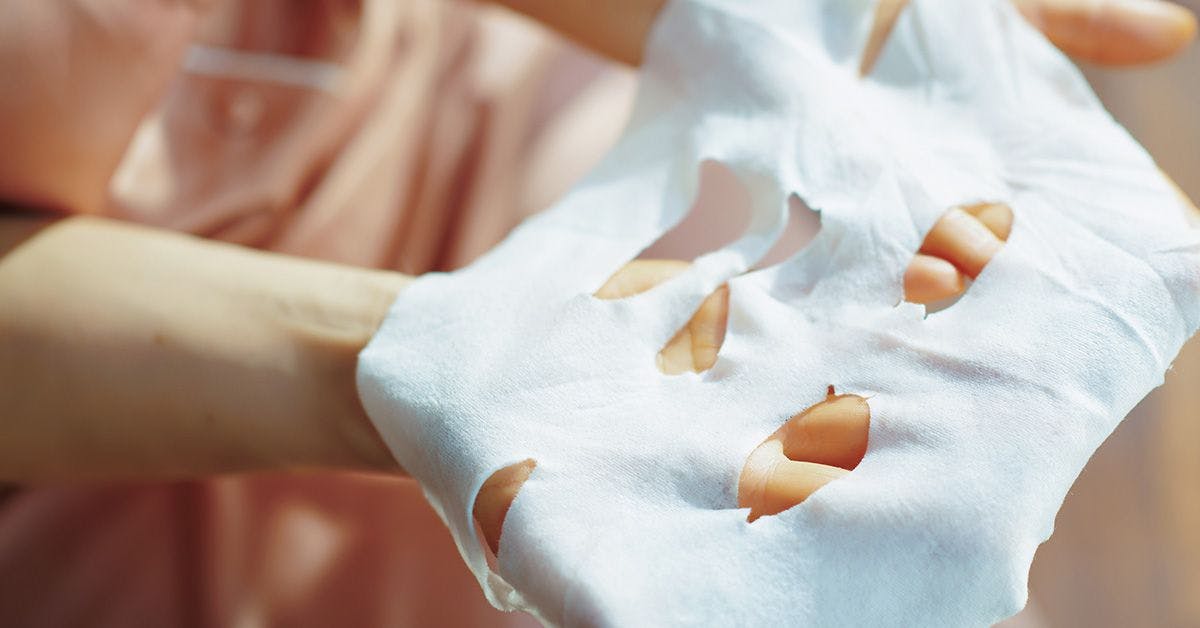A new study in ACS Applied Materials & Interfaces reports on the development of a dry-packaged hydrating facial mask made of bio-based and sustainable materials.

The cosmetics industry is a persistent offender when it comes to the abundant use of plastics and other environmentally harmful additives in both products and packaging. And there is not always a great appetite for change in this market, from consumers abandoning "holy grail" products after reformulation to brands resisting more eco-friendly practices in favor of the bottom line.
As a case in point, a significant number of facial sheet masks still use fabrics made from petrochemical-based plastics, despite the availability of greener materials such as cellulose and silk. But now, a recent study published in ACS Applied Materials & Interfaces reveals a new dry-packaged hydrating facial mask that could give skincare itself a much-needed makeover.
A team from the Department of Biomedical Engineering at the City University of Hong Kong, China, set out to develop a dry, triode-like facial mask using a combination of degradable raw materials, nontoxic and harmless solvents, and electric energy to achieve distinct switchable directional water transport properties. In addition to the green credentials of the fabric itself, the dry sheet mask eliminates the need for wet storage and therefore reduces excessive packaging.1

Electrosprayed Environment-Friendly Dry Triode-Like Facial Masks for Skincare
ACS Applied Materials & Interfaces
DOI: 10.1021/acsami.3c15815
The team previously looked into developing a bioinspired Janus dry mask based on a simple green-solvent-based electrospinning method2—a technique that employs the forces of electrostatic repulsion to pull and stretch the fibers out from a viscoelastic fluid.3 Janus fabrics have also been considered for applications in stretchable electronics and next-generation smart wearables.4
An advantage of electrospun nanofibers is that both the surface and the interior can be equipped with molecular species or nanoparticles.3 In the Janus mask, water could penetrate the nanofibers from the outside to quickly dissolve the inner layer of nutrients, but it was blocked from traveling in the reverse direction5—keeping the outside of the mask dry and facilitating moisture retention. However, the Janus structure was susceptible to peeling, cracking, or falling off in storage due to the poor mechanical strength of the hydrophilic nanofibers.
To improve upon this, the authors developed the new triode-like facial mask (TFM) by electrospraying gelatin microspheres containing green tea extract and hyaluronic acid evenly on one side of a polylactic acid nonwoven fabric. The benefit of electrospraying is that it enhances bonding, avoiding the cracking or peeling of the nutrient layer as experienced with the Janus mask.1
The TFM is activated by either wetting the face first or by applying water directly to the mask. A key innovative feature of the TFM is its ability to control the direction of water transport once it comes in contact with the skin. In its "off-state" (not in contact with skin), the mask prevents water from passing through it. However, when in contact with skin ("on-state"), it allows water to move from the outer surface to the skin. This characteristic is likened to a triode in electronics, where the skin acts like the base current that activates the flow. Watch the authors' video of the directional water transport phenomenon during "on/off" switching below:
Upon testing, the authors also found the TFM to adhere well to moist skin and effectively slow down the evaporation of water. Further tests showed that the gelatin concentration in the microspheres was critical for optimal performance. Findings recorded over 12 days’ twice-daily use in volunteers suggested the TFM helped reduce the proportion of aging cells from 44% to 14% and effectively demonstrated anti-aging, antibacterial, and moisturizing effects.
The authors note that the TFM's unique switchable directional water transport capability, coupled with its skincare benefits, position it as a promising alternative to traditional wet masks and a noteworthy development in sustainable skincare technology. The directional water transport property could also have potential for applications in many industrial processes well beyond the cosmetics industry.
References
- Huang, K. et al. Electrosprayed Environment-Friendly Dry Triode-Like Facial Masks for Skincare. ACS Appl. Mater. Interfaces 2024, 16, 1, 1899–1910.
- Si, Y. et al. Bioinspired Janus All-Natural Electrospinning Membranes with Directional Water Transport as Ecofriendly Dry Facial Masks. ACS Sustainable Chem. Eng. 2022, 10, 23, 7726–7738.
- Xue, J. et al. Electrospun Nanofibers: New Concepts, Materials, and Applications. Acc. Chem. Res. 2017, 50, 8, 1976–1987.
- Dong, J. et al. Perspiration-Wicking and Luminescent On-Skin Electronics Based on Ultrastretchable Janus E-Textiles. Nano Lett. 2022, 22, 18, 7597–7605.
- Hou, L. et al. Interpenetrating Janus Membrane for High Rectification Ratio Liquid Unidirectional Penetration. ACS Nano 2019, 13, 4, 4124–4132.
